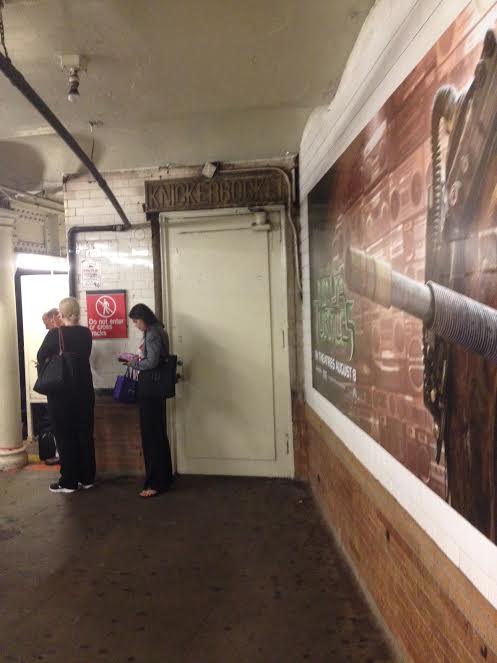Enter the Knickerbocker
Times Square, between Broadway and 7th Avenue on 42nd in the west side of Midtown Manhattan, is a center of activity in New York City. Walk around that area at any time of day and you’ll see many other people around. And underground, there’s a similar level of activity. Times Square is home to one of New York’s more active subway hubs, with roughly a dozen train lines running through it. There’s the 1, 2, and 3 lines, which run up and down the west side and into the Bronx and Brooklyn; the A, C, and E, which criss-cross with the 1, 2, and 3, but go on otherwise similar paths (the E turns east and makes for Queens, though); the N, Q, and R, which start in zig-zag through Manhattan and then go their own ways in Brooklyn, Queens, and perhaps one day up Manhattan’s east side; and the 7, which shoots across 42nd Street, under the East River, past Citi Field, and terminates a stone’s throw away from Nassau County.
And then there’s the S — the 42nd Street Shuttle.
There are three train platforms for the shuttle. (The tracks are numbered 1, 3, and 4; there’s no longer a track 2, which now has a platform built over it.) Each of the trains run on parallel tracks connecting east side to west side. If you’re in Times Square and wait for the train on track 1 (which is generally a good idea, because the walk from there to the train on track 4 often is so long that the train on track 4 leaves the station before you get there), you’re often well-served by walking toward your right. That will be where the front of the train is when you reach Grand Central, and, therefore, you’ll cut a minute or two off your commute. If you take that advice, you’ll see yourself standing roughly where the people in the picture below are standing.

And if you look carefully, you’ll see a door. It’s big and white and isn’t really where one would expect to find a door, especially when you realize that (a) you shouldn’t be able to enter or exit a subway system except for through the turnstiles and (b) there’s no doorknob. If you look up, you’ll see a clue as to why that door is there: a sign which reads “Knickerbocker.”
The predecessor to the shuttle line opened on October 27, 1904. This area became a transportation hub overnight, with untold numbers of people walking through its halls on the way to a train. Two years later, the Knickerbocker Hotel opened. The Astor family-owned business was a 15-story attraction situated directly above the subway platform on the corner of Broadway and 7th Avenues. And with the hotel came that door, which at the time was open to foot traffic — creating an inviting curiosity to urban explorers.
The hotel, shortly after its opening, saw a steady stream of visitors enter its lobby and visit its restaurant, so much so that it surprised many in the hotel’s management. But the hotel saw business dry up when Prohibition hit the United States in 1919. In 1921, the hotel was converted into an office building (it would be the headquarters of Newsweek from 1940 to 1959) and remained so through 1980. Since then, it has served as a residential building (through 2012). Its current owners intend to take the building full-circle, making it a hotel once again, to open sometime in late 2014.
At some point along the way, the elaborate decorations within the corridor were removed and the door was sealed up on both ends. The New York Times gained access to the area (lawfully) and described it as something “an apocalyptic film director or an incurable romantic” would love. It is now used for storage, per the Times, and features “handsome circular ornaments called roundels” which “punctuate some of the plasterwork on the columns” and “a few surfaces” which “retain the elaborate foliate patterns with which they were stenciled when Theodore Roosevelt was president.” The only picture the Times shared, available here, suggests none of this; it’s looks mostly like a big mess. The doorway from the former corridor into the subway station is bricked up, as seen in this picture from the New York Post, and it will likely remain that way — there are no plans to restore the corridor when the new hotel opens.
Instead, the Knickerbocker sign will remain, a mysterious curiosity to most, but a nod to the past to those who know its history.
Bonus Fact: Times Square, roughly speaking, includes a nearly-triangular area of Manhattan bound by 45th Street to the south, 7th Avenue to the east, 46th Street to the north, and Broadway to the west. (Here’s a map.) If you’re there and near 46th Street, you may hear a strange noise coming from below. It’s not the subway, though. It’s an art installation by an artist named Max Neuhaus called “Times Square.” The Dia Art Foundation, which in its own words “identifies, fosters, and presents those artists who have the potential to change the way we think about art and the world,” describes Neuhaus’s work as “a rich harmonic sound texture.” They unfortunately do not explain what that means.
From the Archives: The President’s Secret Train Station: Another unused feature of the New York City underground.
Related: Times Square, the puzzle version.
